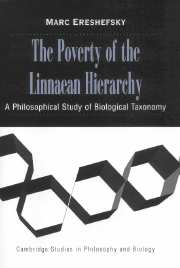3 - History and Classification
Published online by Cambridge University Press: 16 July 2009
Summary
Chapter 1 outlined three main approaches to classification: essentialism, cluster analysis, and the historical approach. Prior to Darwin's work, the prominent view among biologists was that essentialism and cluster analysis are the proper methods for sorting organisms into species. Since then, the historical approach has become the dominant method. Nevertheless, the shift from essentialism and cluster analysis to the historical approach has been controversial. Those biologists who write on the theoretical aspects of biological classification almost universally concur with the shift to the historical approach. Philosophers, however, remain divided. Hull (1976, 1978), Sober (1980, 1984a), Rosenberg (1985a), Williams (1985), and Ereshefsky (1991a) champion the historical approach to biological classification. Kitts and Kitts (1979), Dupré (1981, 1993), Kitcher (1984a, 1984b), and Ruse (1987) favor more qualitative approaches. The first half of this chapter takes up the debate over which approach is appropriate for biological taxonomy. Sections 3.1 and 3.2 outline problems in applying essentialism and cluster analysis to biological taxonomy. Section 3.3 shows why the historical approach is the proper one for biological classification.
Closely associated with the historical approach is the now infamous “species are individuals” thesis. Unfortunately the term “individual” has taken on several meanings in the debate over whether species are individuals. For some authors, an entity is an individual if it is spatiotemporally continuous. For others, individuality requires more than mere spatiotemporal continuity. Disagreement over the meaning of individuality has led to undue confusion.
Information
- Type
- Chapter
- Information
- The Poverty of the Linnaean HierarchyA Philosophical Study of Biological Taxonomy, pp. 94 - 126Publisher: Cambridge University PressPrint publication year: 2000
